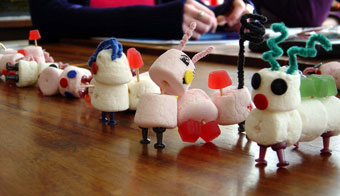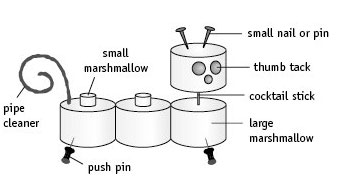Making Reebops: a model for meiosis
Class practical
 Reebops are imaginary animals, made from marshmallows (or foam packing pieces). Their features are determined by the characteristics encoded in their chromosomes. Both parents are heterozygous for all their characteristics (except their sex). Making models in this way has proved very popular with post-16 students – many of whom keep their baby Reebops at home and talk of them with some affection!
Reebops are imaginary animals, made from marshmallows (or foam packing pieces). Their features are determined by the characteristics encoded in their chromosomes. Both parents are heterozygous for all their characteristics (except their sex). Making models in this way has proved very popular with post-16 students – many of whom keep their baby Reebops at home and talk of them with some affection!
Inheritance and variation are two key observations on which the theory of evolution by natural selection is based. You can develop this model of inheritance to show how a population of Reebops could change over successive generations – how it could evolve – if you generate rules to model the advantage that could be conferred on individuals by different characteristics.
Lesson organisation
Prepare for this lesson by explaining what your course requires students to know about the structure of DNA, what genes are, and the fact that chromosomes exist in homologous pairs. Make sure students understand the idea of gametes including one chromosome from each homologous pair, and the offspring having homologous pairs that include one chromosome from the male and one from the female parent.
Present models of adult male and adult female Reebops to the students and draw attention to their characteristics.
Explain that the students have been given instructions for breeding a male and a female Reebop in order to make a baby Reebop, and find out what it might be like.
Provide students working in pairs with the student procedure sheet, envelopes of chromosomes, a decoder key and the materials to build their baby Reebops.
Apparatus and Chemicals
For each group of students:
Envelope of Mum Reebop chromosomes
(Note 1 and see Resources sheet)
Envelope of Dad Reebop chromosomes
(Note 1 and see Resources sheet)
Large marshmallows, white, 4 (Note 2)
Small marshmallows, in three other colours, up to 6 (Note 2)
Cocktail sticks, 5 or 6
Pins, with coloured plastic covers – map pins, thumb tacks or other pins, 8 (Note 2)
Pipe-cleaner, 1
Decoder key, 1 (see Resources sheet)
For the class – set up by technician/ teacher:
Adult male and adult female Reebop (Note 1)
Download ![]() Making Reebops Resource sheet (63 KB).
Making Reebops Resource sheet (63 KB).
Health & Safety and Technical notes
Make sure students don’t eat the marshmallows if you are working in a laboratory.
1 Chromosomes: Photocopy the chromosome templates onto card. Copy the Mum Reebop onto pink or red card and the Dad Reebop onto blue. Laminating the card increases the number of times you can use them. Cut up the chromosomes and secure in bundles with an elastic band.

2 Making adult Reebops: Marshmallows that have dried out slightly work better. You could make the Reebop pieces in any colour, but remember to update the genotype/ phenotype decoder sheet accordingly.
- Join three large white marshmallows with cocktail sticks as ‘ligaments’ to hold them together.
- Attach a head (another large white marshmallow) above the first segment with a cocktail stick.
- Make a tail from a piece of pipe cleaner. Mum and Dad both have curly tails.
- Make four legs with blue push pins.
- Add two antennae – pins of the same colour. Glass-headed dressmaking pins would be ideal here.
- Add eyes – coloured thumb tacks (or small marshmallows).
- Add a nose – a small marshmallow or another kind of pin.
- Add humps to the body segments with small marshmallows, held in place with short pieces of cocktail stick.
- Indicate that your Reebop is male or female. Use your imagination!
Ethical issues
There are no ethical issues associated with this procedure. However, our understanding of this model for allele reassortment is at the centre of applications such as genetic disorder screening and other selective reproduction techniques. Be prepared for discussions around this model that introduce these ethical issues.
Procedure
SAFETY: Do not allow students to eat the marshmallows if you are working in a laboratory. Even in a classroom, discourage eating the marshmallows after they have been handled and stuck with pins!
Preparation
a Make up the adult Reebops, the decoder key and the chromosome cards.
b Collect enough material to make one baby Reebop for every working pair.
Investigation
c Discuss the adult Reebops and their features.
d Allow students to read and follow instructions on sorting and re-assorting the chromosomes.
e Allow students to decode the genotype of their baby Reebop and build a model.
f Discuss the outcomes.
Teaching notes
The whole exercise is a model for the processes of meiosis, fertilisation and development. You can draw attention to what happens when working with the model, and highlight how they reflect (or differ from) our ideas about the living process. Here are some examples.
- An elastic band keeping the chromosomes together can be thought of as representing histone proteins or the nuclear envelope.
- If students ‘get it wrong’, consider any mistakes carefully and try to draw parallels with natural errors such as non-disjunction or mutations.
- Extend the exercise further by choosing two babies; allow them to ‘mature’ rapidly, and use them as parents for the next generation.
- Draw up family trees to follow the inheritance of selected features.
- If your new adults are both heterozygous for a dominant feature and starting a new population, think about the outcome of introducing a recessive mutation for some feature and see how it could spread through a population.
- Consider how natural selection might act on this group of animals. Which features could confer an advantage? or a disadvantage in certain situations? How could a characteristic be eliminated from a population? If you split the Reebops into two groups, how might they develop differently in different situations?
Eight chromosomes should give a good range of phenotype expression (384 possible outcomes). If you have a large class you might want to introduce extra features, such as wings or gills, to increase the variation between the offspring. If so, include an extra chromosome, extra materials and extra information on the decoder key.
Downloads
Download the student sheet ![]() Making Reebops: a model for meiosis (70 KB) with questions and answers.
Making Reebops: a model for meiosis (70 KB) with questions and answers.
Downloads the ![]() Making Reebops Resource sheet (63 KB).
Making Reebops Resource sheet (63 KB).
Original SNAB ![]() Teachers Notes (54 KB),
Teachers Notes (54 KB), ![]() Technicians notes (67 KB) and
Technicians notes (67 KB) and ![]() Student Sheets (191 KB).
Student Sheets (191 KB).
Acknowledgement
Adapted with permission from Salters-Nuffield Advanced Biology. Pearson Education 2008. Original source material is available as pdfs attached to this document.


